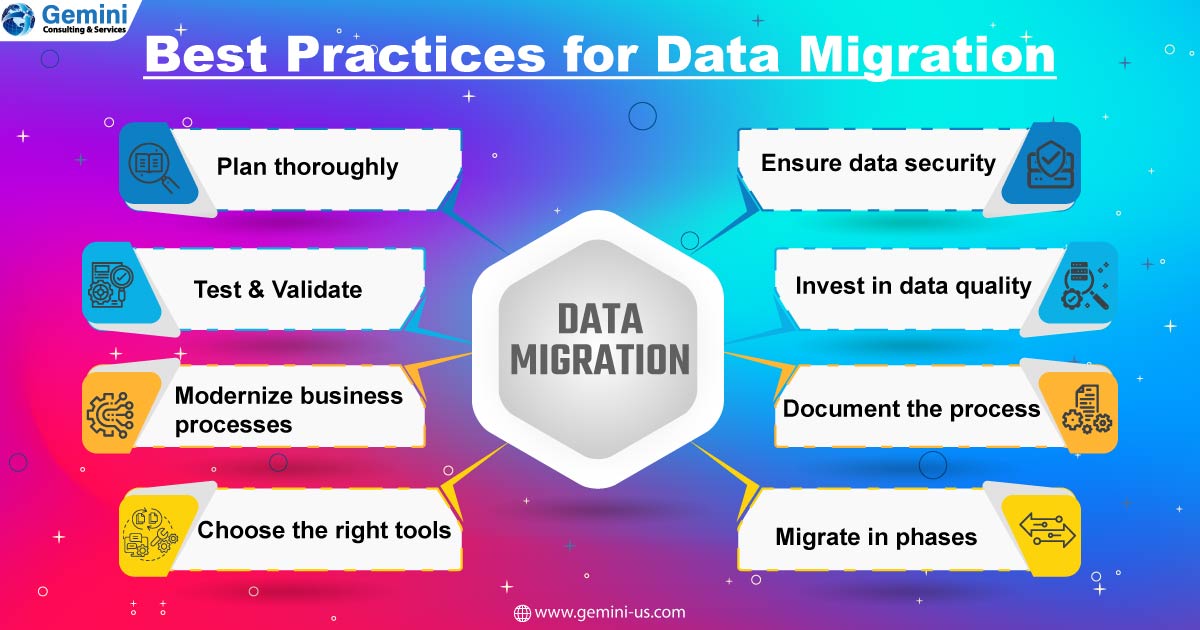Data migration is critical for enterprises looking to upgrade their system or server, consolidate storage hardware, and change databases, data centers, or data formats between Hard Disk Drive (HDD) to Solid State Drive (SSD). Data migration needs proper planning, knowledge, and teamwork to meet objectives. A defined and planned migration process ensures data is transferred successfully and securely, preventing corruption or loss from using incompatible devices or poor data execution.
According to Forbes, successful data migration requires appropriate investment, time, and effort. Lift and shift of master and historical data will not work. Businesses must right size and clean data for 99.5% or better data quality.

Why Do Enterprises Execute Data Migration?
- Replacing a legacy system with another that is more aligned with the needs and goals of the business.
- To cut down the operational costs of data storage footprints and transferring data to systems that consume less power.
- To deploy new technologies that help businesses to remain innovative and competitive.
- Prepare a strategy for disaster plan implementation
- Implementing a cloud computing environment
Enterprises need to create an efficient data migration strategy. Enterprises can adopt the big bang or the trickle approach for data migration. Enterprises need to move all data, applications, and other pre-identified assets at once if they are opting for a big bang migration strategy. This may lead to system downtime. It is the quickest route since all aspects are moved simultaneously, but it tends to be complex and risky.
Businesses that can’t afford extended downtime and those who meticulously comb through data security and compliance protocol during this process have fewer chances of benefitting from this approach. The trickle migration approach handles migration in phases and allows for a more controlled and less intensive migration, which does not burden IT teams and business operations. It is also less expensive. However, it is a time-intensive exercise and does not suit those businesses on a tight migration schedule.
The trickle migration approach allows businesses to run their old infrastructure, but risks are not entirely avoidable; a phased approach according to business-specific requirements will help.

Here are some strategies and best practices for handling enterprise data migration.
Plan Thoroughly: A successful data migration strategy requires thorough planning. Enterprises should identify the data to be migrated, the source and target systems, and the required data quality. This should be followed by an assessment of any risks and challenges that may arise during the migration process.
Test and Validate: Before the actual data migration, it’s important to perform several tests to validate the migration process. This includes testing the data quality, compatibility with target systems, and ensuring that all business processes are working properly.
Modernize Business Processes: Data migration provides an opportunity for enterprises to modernize their business processes. This means that enterprises should take advantage of the migration process to update their data management and governance policies.
Choose the Right Data Migration Tools: The choice of data migration tools is crucial for a successful data migration process. Enterprises should select tools that are compatible with their source and target systems and have the ability to handle complex data formats.
Ensure Data Security: During data migration, data security should be a top priority. Enterprises should ensure that sensitive data is protected from unauthorized access and is encrypted during transit.
Invest in Data Quality: To ensure a successful data migration, enterprises must invest in data quality. This involves cleaning and verifying data to eliminate errors, redundancies, and inconsistencies.
Document the Migration Process: Documenting the data migration process is important to ensure that future migrations are easier and less risky. Enterprises should document the source and target systems, the migration process, and any issues that arise during the migration.
Migrate in Phases: It is better to divide migration into various phases, enabling micro-targets that make it easy to track progress and identify potential roadblocks. Doing live tests and trials help with assessment, planning against the live process, and adjusting their migration strategy to control the process. Audit and testing post-migration are also greatly recommended.
Data migration is a critical process that requires proper planning, knowledge, and teamwork to ensure a successful outcome. Gemini Consulting & Services can assist enterprises in planning and implementing effective data migration strategies. Businesses should invest in data quality, choose the right migration tools, modernize business processes, and ensure data security to achieve a successful data migration. Contact us to successfully carry out your enterprise data migration.
Make Your Business Migration-Ready
Strategic assessment and defined responsibilities an help enterprises handle the complexities of data migration. Partnering with the right expert will help businesses hire a dedicated migration team with data experts who can manage the process and the technologies while communicating with appropriate stakeholders. By handling the migration with a solid strategic plan and detailed follow-through, businesses can effectively modernize their workflows and improve many other aspects of their business.



